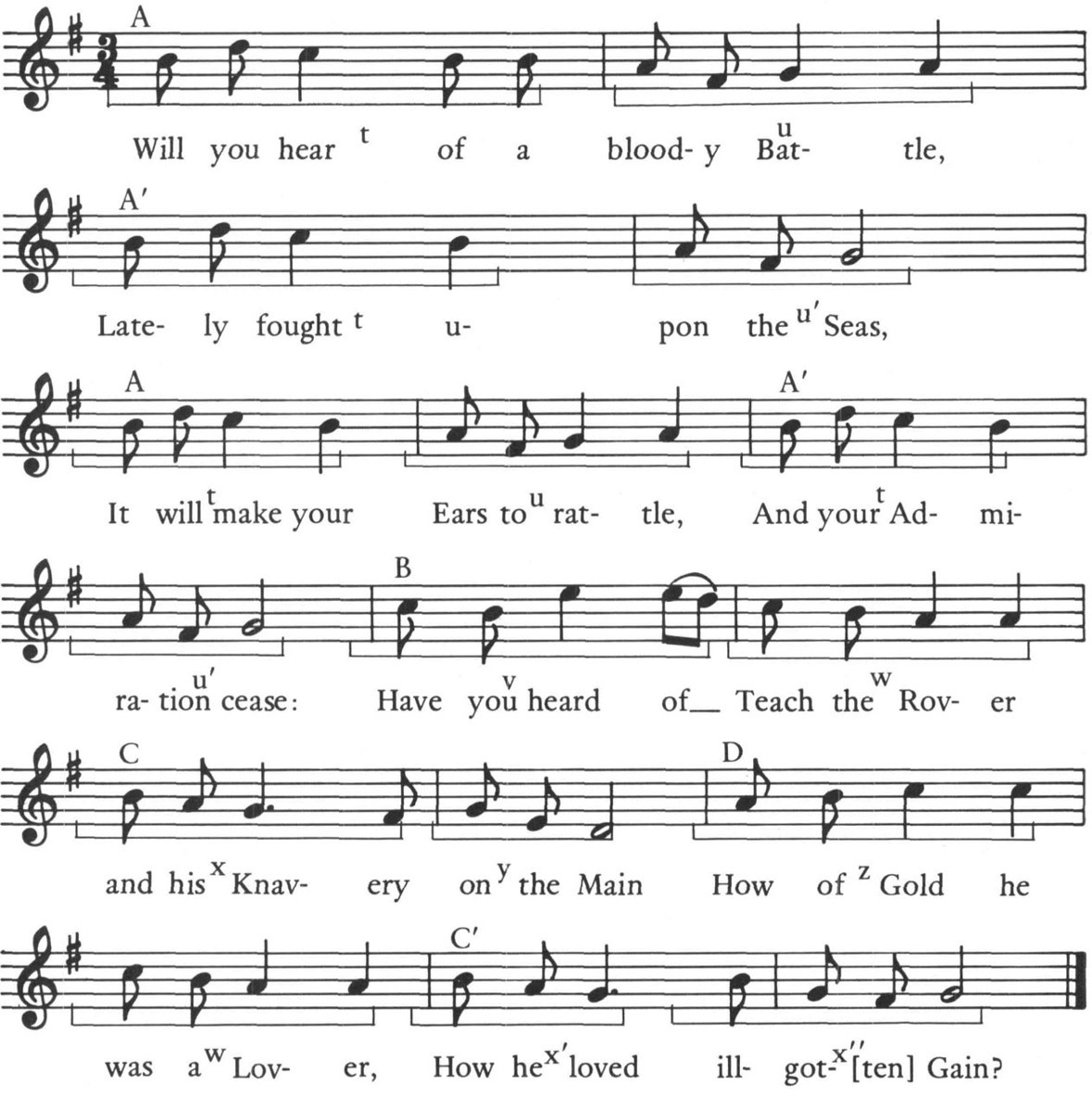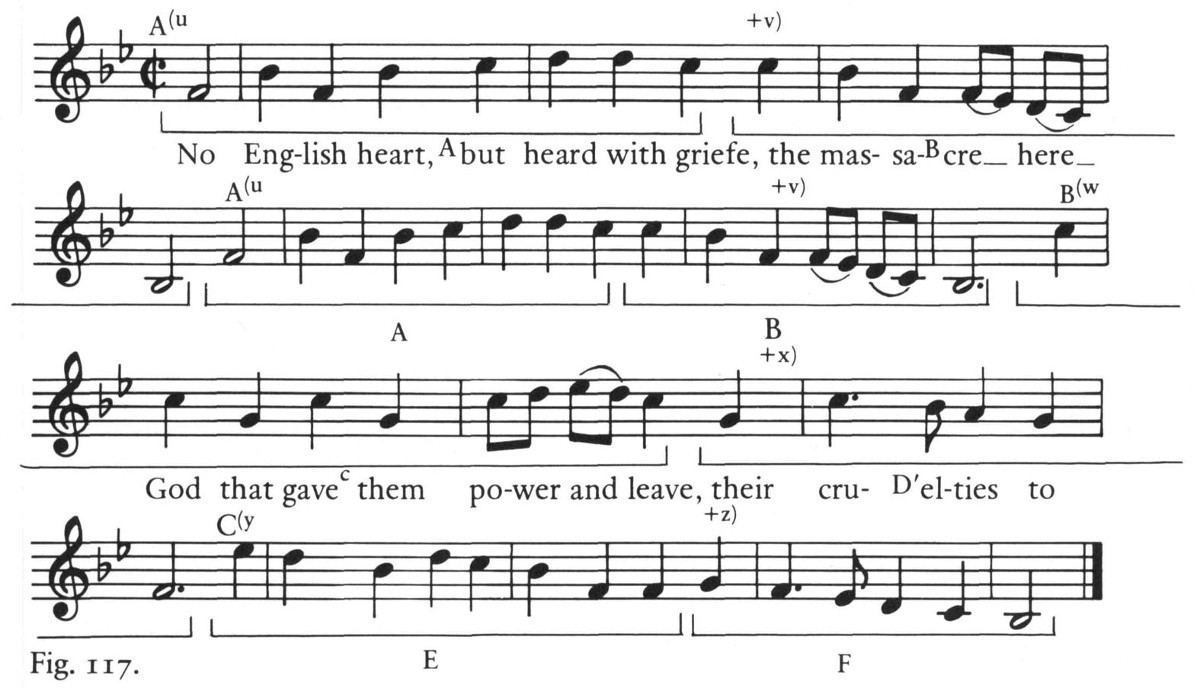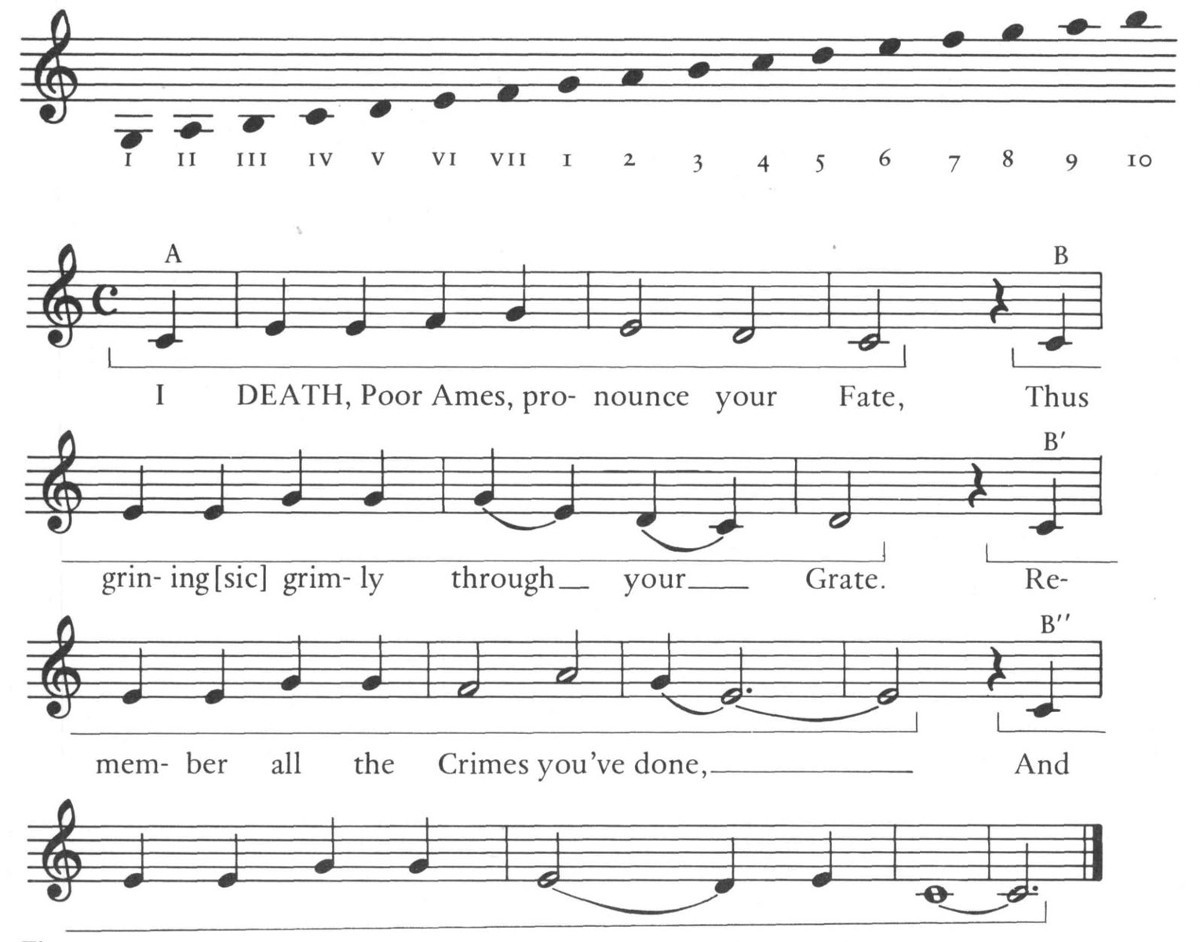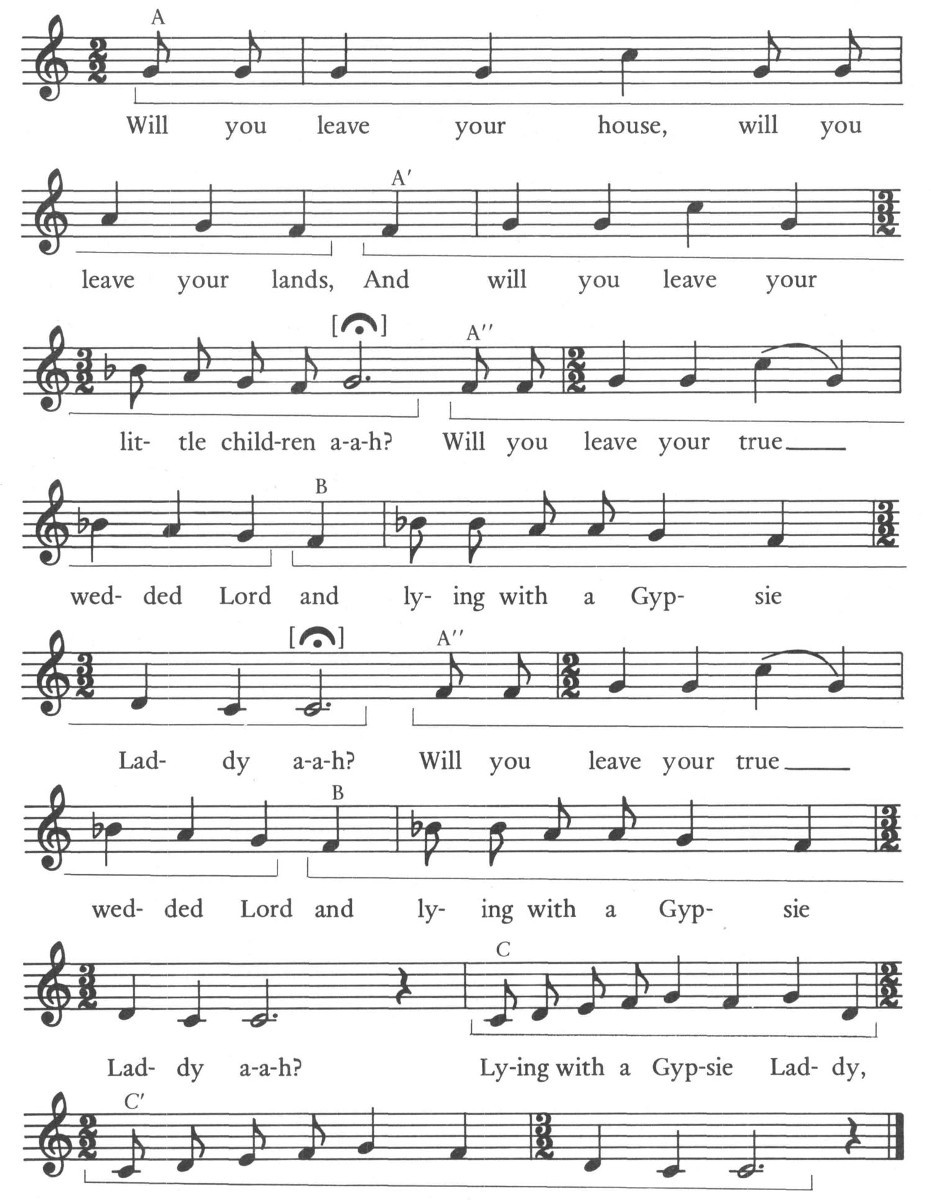Appendices
A.
COMMENTARY ON THE TUNES
by Israel J. Katz
The seventy-one musical examples in this study were obtained from a wide variety of manuscript and printed sources, including broadsides. Inasmuch as their provenance comprised England, Ireland, and the eastern seaboard of the United States, it is interesting to note that among the early sources, the English ballad operas and such items as hymnals, The Fitzwilliam Virginal Book, and John Play ford’s The English Dancing Master figured prominently. Several of the tunes were taken down from oral transmission by such noteworthy collectors as Lucy Broadwood (fig. 223), Helen Hartness Flanders (figs. 208 and 212), Elisabeth Bristol Greenleaf (fig. 153), John and Alan Lomax (fig. 206), and Cecil Sharp (figs. 140, 198, 201, and 234). Therefore, all the notated sources reflect both the melodic and rhythmic nuances perceived by their individual transcribers, who in the majority of cases retrieved the tunes from the extant tradition. Such nuances should be borne in mind when confronting variants for particular melodies. Likewise, the varied contrafact text underlays have also affected their melodic lines.
Above each musical illustration, one will find information pertaining to the tune’s formal structure, modality, and ambitus (range). For the musically minded reader, such information will facilitate an immediate recognition of the tune’s morphology and modality, given in its authentic, plagal, or mixed type.
The practice common to all the tunes is their strict adherence to the strophic principle; i.e., their successive textual stanzas are sung to the initial melody strophe, which ranges in structure from a simple quatrain through octavo strophes containing internal and end refrain burdens. The basic structural configuration is indicated by capital letters. Thus, ABCD represents a quatrain strophe of four unrelated musical phrases; ABABCDAB, an octavo strophe in which the first two phrases are repeated three times. The italicized letters indicate the phrases which carry refrain burdens; e.g., ABCDEFG (fig. 165b) may be considered as a quatrain strophe linked to an end refrain comprising three phrases, or ABCDEFBD′BD (fig. 236), which bears internal and end refrains. The prime symbol (′) denotes a variant form of the same phrase; e.g., AA′AA′BCDC′ (fig. 114) or ABB′B″ (fig. 223), in which B″ exhibits yet another melodic (rhythmic) deviation.
A closer look at several of the examples will reveal additional insights into the intricacies of formal structure:
- 1. In figure 114, the individual phrases can again be subdivided utilizing exponential nomenclature such as At+u At+u′ At+u At+u′ Av+w Cx+y Dz+w Cx′+x″.

Fig. 114.
- 2. Figure 117 typifies the compound quatrain—in this case an AABC strophe. Each of the phrases, referred to here as “long” because they comprise bipartite divisions, allows the formal structure to be depicted either as Au+v Au+v Bw+x Cy+z or ABABCDEF. Preference has been given to the latter configuration for all such strophes of the compound quatrain type.

Fig. 117.
- (Additional examples of this type can be found for figures 120, 121, 124, 140, 142, 144, 145, 149, 151, 158, 160, 163, 171, 181, 183, 187, 195, 206, 221, 227, and 231.)
- It should be noted that the long phrases comprise both the popular Long and Common Meter designations, which carry verses of 8+8 and 8+6 syllables, respectively. Additional verse patterns included among the tunes are 10+10 (fig. 179), 8+7 (figs. 114, 115, 144, 145, 171, and 227), 7+7 (fig. 229), 7+6 (figs. 160 and 173, the first two “long” phrases only), 6+5 (which also occurs in the first two phrases of the quatrain strophe, fig. 175), and 6+5 (fig. 153).
- 3. Figure 201 illustrates the structural components of a distinctly Mixolydian tune. Such structural dissections present a lucid view of the basic relationships among the individual phrases.
- 4. Figure 223 represents yet another close scrutiny of the structural relationships.
For convenience in locating the formal structure of the varied melody strophes, the reader is referred to Table I.
With regard to modality, the major and minor modes constitute 61% of the total modes utilized. The authentic modes, i.e., those whose tones move between the tonic and its octave, are not indicated as such. The plagal modes move between the upper and lower 5th, and the mixed comprise the authentic and plagal types.
The major mode (authentic, 23%; plagal, 20%; and mixed, 7%) and minor mode (authentic, 6%; plagal, 4%; and mixed, 3%) are followed by the Dorian (8%) and Mixolydian (4%). The remaining tunes, yielding incomplete scales, are either six-tone (hexachordal, 8%; and hexatonic, 8%) or five-tone (pentachordal, 4%; and pentatonic, 5%).
The modal distribution is given in Table II.
Finally, the following Table III, which contains the distribution of ambitus, is based upon the following double-octave scale to which all the tunes have been coordinated, i.e., with the finalis on g (indicated as no. 1 on the staff).

Fig. 223.
Tunes which are described as “circular” are those which do not end on their tonic or finalis, but which end, rather, on an adjacent tone or fifth degree (lower or upper), thus producing a sense of continuity or “circularity.”
table i
Formal Structure of the Melody Strophes
|
AA′AB |
(147c) |
AA′A″BA″BCC′ |
(201) |
|
AABA |
(153) |
ABABCA′CA′ |
(179) |
|
AA′BA |
(215) |
ABAB′CBAB′ |
(206) |
|
AABC |
(115, 177, 203, 204) |
ABABCC′DB |
(164) |
|
AA′BC |
(138) |
ABAB′CC′DE |
(149) |
|
ABA′C |
(147a) |
ABABCDAB |
(140, 171) |
|
ABBA |
(175) |
ABABCDAB′ |
(120, 221) |
|
ABB′B″ |
(223) |
ABAB′CDAB′ |
(121) |
|
ABBC |
(212) |
ABAB′CDA′E |
(187) |
|
ABB′C |
(208) |
ABABCDEB |
(151) |
|
ABCA |
(214) |
ABABCDEF |
(117, 124, 163, 181) |
|
ABCD |
(112a, 112b, 126, 128, 130, 135, 147b, 191, 192c, 197, 198, 217, 219, 226, 229) |
ABAB′CDEF |
(160) |
|
ABACDEAF |
(233) |
||
|
ABA′CDEA′F |
(195) |
||
|
ABCDEBCD |
(142) |
||
|
ABCDE |
(189) |
ABCDEE′CD |
(158) |
|
ABCDEFAB |
(227) |
||
|
ABABCC′ |
(200) |
ABCDEFGB |
(132) |
|
ABCDEF |
(210) |
ABCDEFGH |
(144, 145) |
|
ABCDEFGH |
(168) |
||
|
ABABCDE |
(162) |
||
|
ABA′CDEF |
(173) |
ABCDEFC′GG′ |
(156) |
|
ABCDEFG |
(185) |
ABCDEFGHI |
(155) |
|
ABCDEFG |
(165b) |
||
|
ABAB′CDABAB′ |
(234) |
||
|
AA′AA′BB′BB′ |
(231) |
||
|
AA′AA′BCDC′ |
(114) |
ABCDEFBD′BD |
(236) |
|
AA′AA′BCDE |
(183) |
ABCDEFCD′E′FCD |
(110) |
The Distribution of Modes
|
Major (117, 126, 149, 151, 160, 163, 165b, 198, 208, 219, 229) |
Mixolydian (201) |
|
Mixolydian (plagal) (140, 206) |
|
|
Major (plagal) (112a, 112b, 114, 115, 124, 128, 147a, 147b, 162, 164, 171, 173, 185, 200, 226, 234) |
Hexachordal (−7) (197) |
|
Hexachordal (−7) Major (223) |
|
|
Hexachordal (−7) (plagal) (138, 187, 195) |
|
|
Major (mixed) (144, 145, 155, 156, 168, 183, 210) |
Hexachordal (−7) (mixed) (175) |
|
Hexatonic (−2) (221) |
|
|
Minor (120, 181, 189, 227) |
Hexatonic (−6) (215, 231) |
|
Minor (plagal) (110, 179) |
Hexatonic (−6) Minor (plagal) (153) |
|
Minor (mixed) (142, 158, 233) |
Hexatonic (−6) (plagal) (130, 236) |
|
Dorian (203) |
Pentachordal (−6, −7) (Minor) (147c, 192c, 204) |
|
Dorian (plagal) (121, 135, 191) |
|
|
Dorian (with raised 7th) (132, 177) |
Pentatonic (−4, −7) (212, 214, 217) |
table iii
Distribution of Ambitus (Range)
|
i–3 |
(165b) |
|
i–5 |
(163, 168, 204) |
|
i–6 |
(144, 145, 223) |
|
i–7 |
(203) |
|
i–♯7 |
(198) |
|
i–8 |
(149, 191, 197, 201, 215, 229) |
|
i-♭10 |
(181) |
|
i–10 |
(219) |
|
i—11 |
(117) |
|
iI–4 |
(162) |
|
♭iii–5 |
(110, 147c, 192c, 212) |
|
iii-♭3 |
(179) |
|
iii–4 |
(164, 171) |
|
iii–5 |
(124, 147a, 173) |
|
iii–6 |
(226) |
|
iv–5 |
(135) |
|
iv–8 |
(158) |
|
v–3 |
(214) |
|
v–5 |
(112a, 112b, 128, 130, 132, 147b, 185, 200, 236) |
|
v–6 |
(114, 115, 138, 140, 187, 195, 234) |
|
v–7 |
(121, 153, 206, 233) |
|
v–8 |
(142, 175, 183, 210, 217, 227) |
|
v–9 |
(156) |
|
v–10 |
(155) |
|
vi–7 |
(120) |
|
vi–8 |
(151) |
|
vii–5 |
(231) |
|
vii–9 |
(221) |
|
♯vii–7 |
(177) |
|
♯vii–8 |
(126, 160, 189, 208) |
B.
PROGRAMS OF TWO CONCERTS
A CONCERT OF MUSIC PERFORMED IN EIGHTEENTH-CENTURY MASSACHUSETTS
david mckay and daniel pinkham, directors
faneuil hall, boston
May 17, 1973, 8:30 p.m.
- I. Plain and fuguing tunes
William Billings (1746–1800)
Connection
The Continental Harmony, 1794
Oliver Holden (1765–1844)
Coronation
The Union Harmony, 1793
William Billings
David’s Lamentation
Singing Master’s Assistant, 1778
William Billings
Kittery
Suffolk Harmony, 1786
- II. Set pieces
William Billings
Creation
The Continental Harmony
William Billings
Modern Music
Psalm Singer’s Amusement, 1781
- III. Choral works
S. Falsted
Grand chorus horn Jonah, an Oratorio, American premier, in Boston, 1789, under the direction of William Selby
William Selby (1738–1798)
Matchless Is Thy Form
Robert Smith, tenor solo
- IV. Seasonal works
Josiah Flagg (1738–1794)
Christmas Hymn
Sixteen Anthems, 1766
William Billings
Anthem for Easter
Bound with Suffolk Harmony
William Billings
Judea
Singing Master’s Assistant
Supply Belcher (1751–1836)
Spring
Harmony of Maine, 1794
- V. For entertainment
George Jackson (1745–1823)
Waft Me Some Soft
New miscellaneous musical work
Gentle Breezes
Women’s Voices
Anonymous
An “Instrument” Song
Early American Shaker tune
William Billings
Jargon
Singing Master’s Assistant
Timothy Swan (1758–1842)
Merrily Sing
The Songster’s Assistant, 1800
(canon)
William Billings
Rose of Sharon (abridged version)
Singing Master’s Assistant
The David McKay Chorus; David McKay, Director Daniel Pinkham, organ accompaniment
- VI. Broadside ballads
Grecian Daughter
A Dialogue between Death and a Lady
Father Abbey’s Will
The Death of General Wolfe
Fortune My Foe
The Bundling Song
Sally Smith, soprano
Mark Baker, baritone
Hopkinson Smith, lute and cittern
A CONCERT OF MUSIC PERFORMED IN SEVENTEENTH-CENTURY MASSACHUSETTS AND IN THE CHURCHES IN THE EIGHTEENTH CENTURY
daniel pinkham, director king’s chapel, boston
May 18, 1973, 2 p.m.
|
Masonic Processional March |
Samuel Holyoke (1762–1820) |
|||
|
for orchestra |
||||
|
Concerto in D Major |
John Stanley (1713–1786) |
|||
|
for orchestra |
||||
|
Largo Allegro Adagio Allegro Adagio Allegro Adagio Allegro |
||||
|
Solo violins: Stavros Margaritis and Peggy Foye |
||||
|
Violoncello: Anne Callahan |
||||
|
for organ and orchestra |
Johann Christian Bach (1735–1782) |
|||
|
Allegro con spirito |
Tempo di minuetto |
|||
|
Solo organ: Douglas Bildt |
||||
|
Members of the Collegium Musicum of the New England Conservatory |
||||
|
Violins: Peggy Foye, Stavros Margaritis |
Oboes: Barbara Knapp, Linda Lingle |
|||
|
Viola: Jane Starkman |
Bassoon: Philip Long |
|||
|
Violoncello: Anne Callahan |
Organ continuo: Douglas Bildt |
|||
|
Double bass: Jeffrey Aaron |
Conductor: Daniel Pinkham, of the Faculty |
|||
|
Pieces from Musick’s Handmaid and A Choice Collection of Lessons |
Henry Purcell (1659–1695) |
|||
|
Virginals: John Gibbons, Harpsichordist to the Leslie Lindsey Mason Collection of Musical Instruments, Museum of Fine Arts, Boston |
||||
|
Psalm I |
Henry Ainsworth (b. ?–1622) |
|||
|
Lord, Hear My Prayer |
William Byrd (1543–1623) |
|||
|
Praise the Lord, O My Soul |
John Mundy |
|||
|
Psalm 130 |
Thomas Ravenscroft (ca. 1590–ca. 1633) |
|||
|
Psalm 98 |
Thomas Ravenscroft |
|||
|
Psalm 116 |
Bay Psalm Book (1695) |
|||
|
Singers |
||||
|
Heidi Hermansen |
Philip Fields |
|||
|
Gale Fields |
Douglas Bildt |
|||
|
Students at the New England Conservatory |
||||
|
Conductor: Philip Fields |
||||

